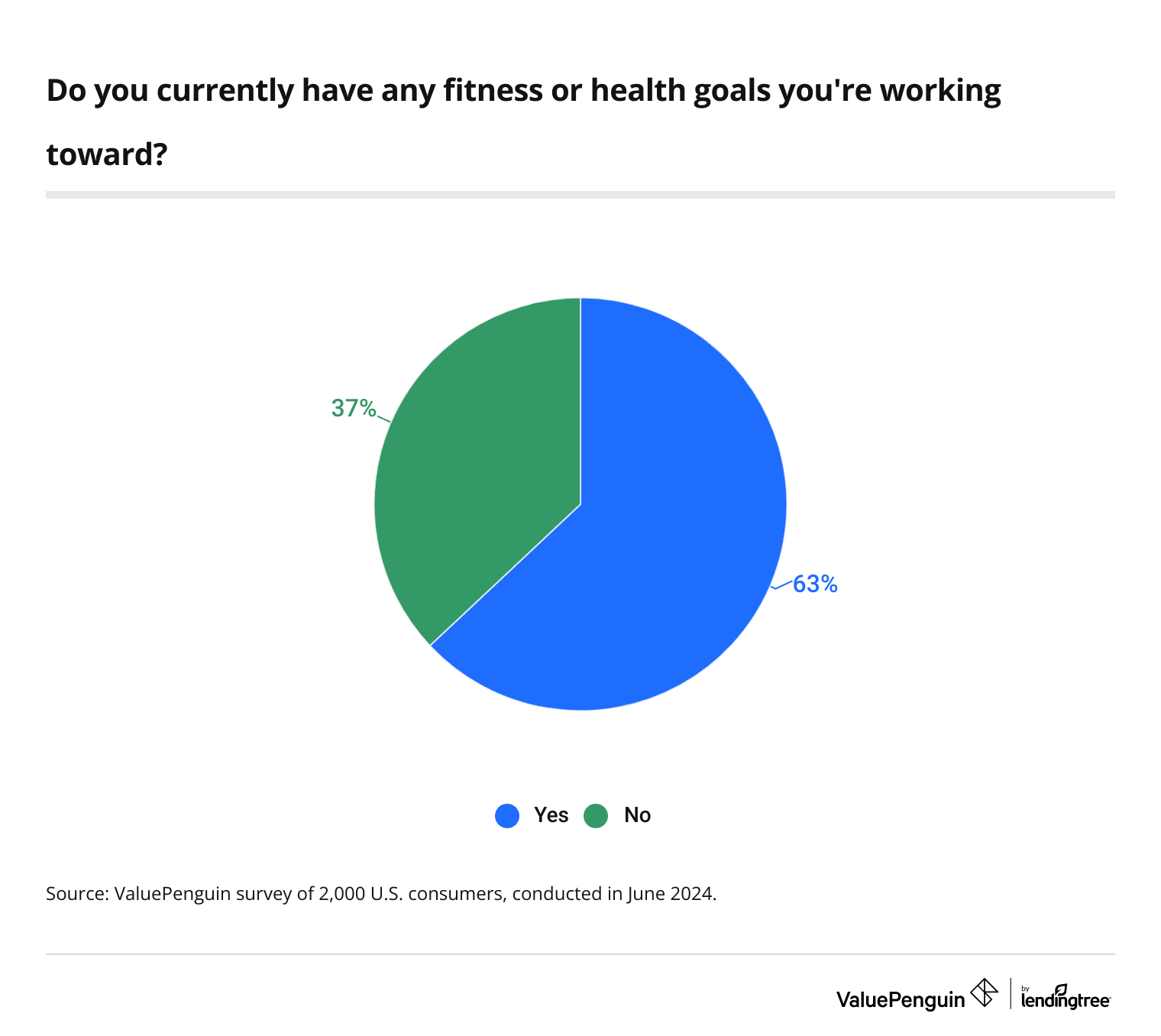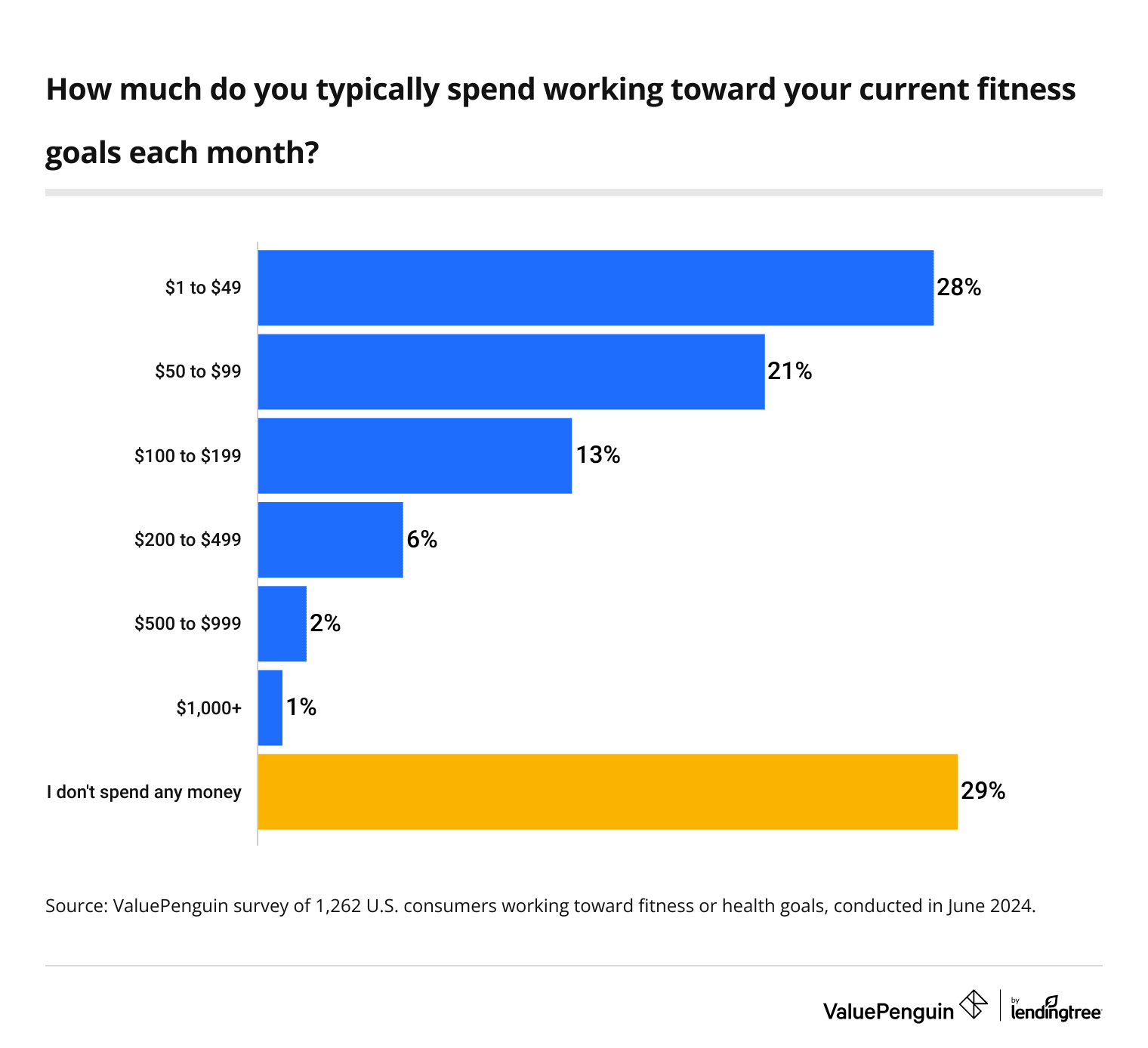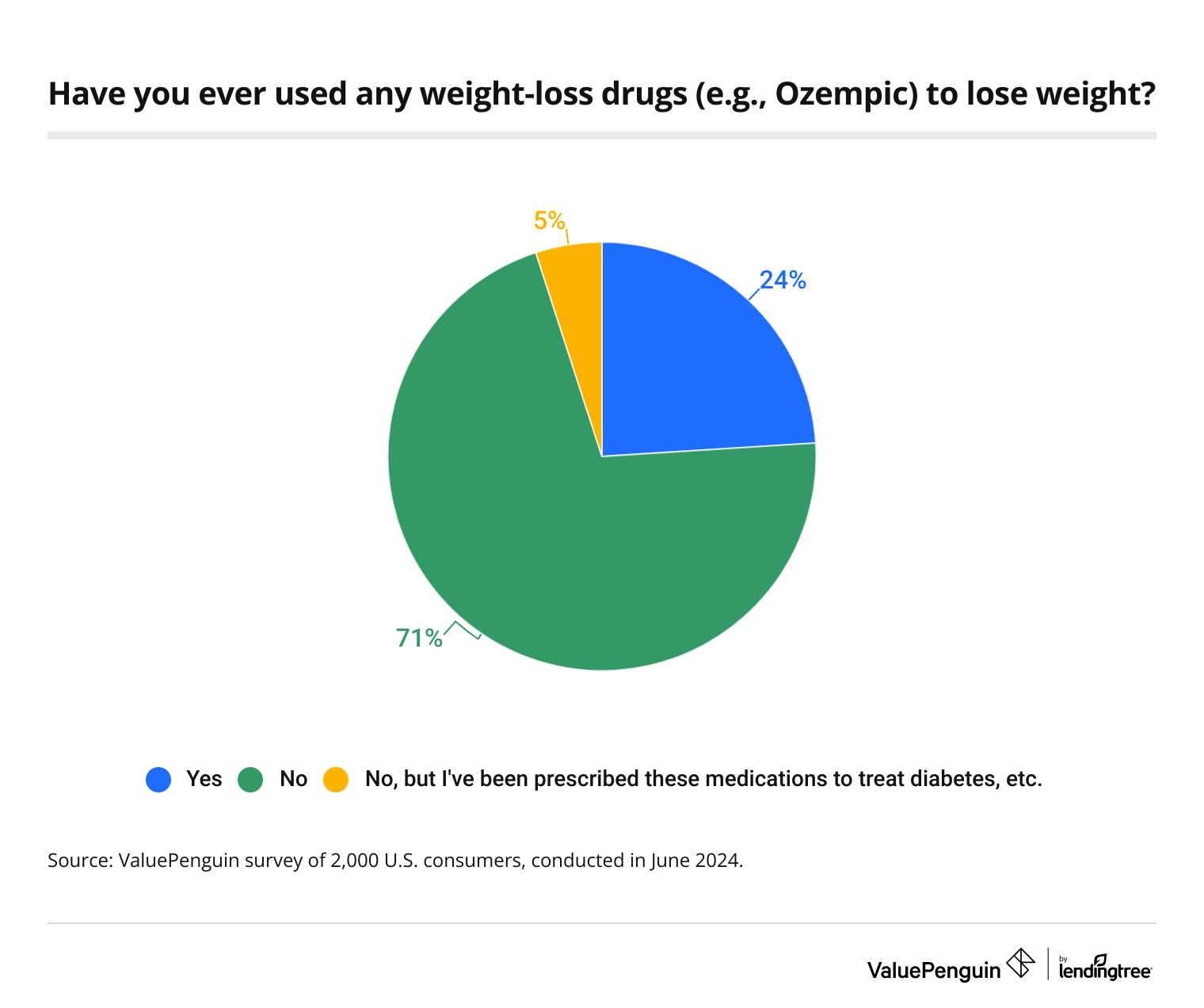Health Insurance
2024 American Fitness Report

The majority of Americans (55%) are happy with their bodies in terms of physical fitness, physique and weight, according to the newest ValuePenguin survey of 2,000 consumers. And our 2024 American Fitness Report found that even those happy with their bodies still have health-related goals they’re working to achieve.
Of course, maintaining or reaching health-related fitness goals often involves additional expenses. Depending on your health insurance policy, you may have coverage to support those expenses. Nonetheless, investments in your health could be worthwhile because of the possible physical payoffs and the money good health might save you on insurance and health care costs.
On this page
Key findings
- More than half of Americans are happy with their bodies. 55% of Americans are happy with their physical fitness, physique and weight, a figure that’s highest among those with children younger than 18 (66%), Gen Zers (64%) and men (61%). Among those who aren’t happy, 34% say it’s been more than five years since they were, and 24% say they’ve never been.
- Even if they’re happy with their body, many still have health goals. 63% of Americans have a health or fitness goal they’re working toward, and 43% are actively trying to lose weight. Among those working toward a goal, 84% are confident they’ll reach theirs. Overall, 34% of Americans feel they’re always on a diet.
- Health is synonymous with spending for some. 71% of Americans with health goals typically spend money each month to progress toward those goals. However, 42% of consumers admit they’ve had to cut back on fitness spending to save money, with 40% of them saying it negatively affected their health. Across all Americans, the most common expenditures are fitness studios or gyms (24%), workout attire (19%) and workout equipment (17%).
- Many have turned to pharmaceutical help. Almost a quarter (24%) of Americans have used weight-loss drugs to shed weight, and 16% who haven’t would like to. Additionally, many Americans wish for more help from their insurers, as 57% say theirs doesn’t cover any weight-loss, nutrition or fitness services — but 66% think they should.
More than half of Americans are happy with their bodies
Most Americans (55%) say they’re happy with their bodies when it comes to physical fitness, physique and weight. That figure is highest among:
- People with children younger than 18 (66%)
- Gen Zers ages 18 to 27 (64%)
- Men (61%)
Yet it’s important to note that not everyone feels content with their body, including 56% of baby boomers ages 60 to 78, 54% of parents with adult children and 51% of women.
Among those who don’t feel happy in their bodies, 34% say they’ve felt that way for more than five years, and 24% say they’ve always felt unhappy in their body. Almost 1 in 3 Gen Zers (31%) not happy with their body have never been.
How Americans exercise
When it comes to working out, 40% of Americans (and 53% of Gen Zers) prefer to use exercise as a time of solitude, while 19% like to exercise with other people. Meanwhile, 37% say exercise helps them feel better and improves their mental health. Another 24% accept exercise as a necessary evil they don’t really enjoy, understanding that it’s important nonetheless.
As far as how much Americans exercise, those figures vary. In a typical week, here’s how much Americans exercise on average:
- 0 hours: 13%
- Less than 1 hour: 13%
- 1 to 2 hours: 22%
- 3 to 4 hours: 23%
- 5 to 6 hours: 14%
- 7 to 8 hours: 9%
- 9 to 10 hours: 4%
- More than 10 hours: 4%
Even if happy with their body, many still have health goals
Although most Americans are happy with their bodies, the majority (63%) have health goals they want to achieve. This is highest among Gen Zers (75%) and parents of young kids (69%).

Among those with fitness and health goals, 84% are optimistic, believing they’ll successfully reach them. This is highest among parents with young children (88%), Gen Xers ages 44 to 59 (87%) and millennials ages 28 to 43 (86%).
When it comes to specific health goals, here are the health-related accomplishments respondents aim to accomplish:
- Lose weight and/or get fit: 43%
- Maintain current weight and/or fitness level: 30%
- Gain weight and/or bulk up: 13%
It’s also worth noting that 34% of Americans say they feel like they’re always on a diet, led by parents with young children (41%).
Health is synonymous with spending for some
For many people, working toward health-related goals equates to more spending. In fact, 71% of Americans with a health goal spend money monthly to try to make progress toward reaching it, including 82% of parents with young kids and 80% of millennials and men.
Here’s a closer look at how much Americans with fitness goals spend each month:

ValuePenguin health insurance expert Divya Sangameshwar says, "Investing money in your health, especially on preventive health care like fitness, healthy food or supplements, can save you money in the long term by keeping chronic illnesses (often very expensive to diagnose and treat) at bay."
However, she also notes that spending too much on health-related goals hinges on your unique financial circumstances — and how you spend your dollars.
"As a rule of thumb, don’t take on debt for your health, especially if the expenses are avoidable or if there are cheaper alternatives," Sangameshwar says. It’s also important to know your financial limits when it comes to health-related expenses.
Our survey asked respondents with fitness goals to share the maximum amount (up to $100,000) they’d pay to instantly reach their fitness goals. Below are the average responses overall and by gender:
- Americans: $7,145.40
- Men: $8,098.50
- Women: $6,096.90
Americans with fitness goals also had the opportunity to reflect on whether their current diet supported their fitness goals. The majority (72%) said yes, but a minority (28%) didn’t feel their diet was supportive.
When it comes to fitness spending, 42% of Americans admit they’ve had to cut back in the past year to save money. Out of all Americans, here are some of the common budget cuts people chose in an effort to save:
- Exercise (e.g., gym memberships, fitness classes, personal training): 22%
- Healthy foods: 16%
- Weight-loss medications: 8%
Unfortunately, 40% who reduced their fitness spending say it had a negative impact on their health. This was led by 45% of millennials.
Among Americans, below are some of the most common areas where people are spending money at least once a year:
- Gym or fitness studio memberships: 24%
- Workout attire: 19%
- Workout equipment: 17%
- Workout classes: 13%
- Online fitness apps or videos: 13%
- Personal trainer fees: 9%
- Nutritionist or dietician: 9%
- Body-centric cosmetic surgeries or procedures: 8%
Across all demographics, Gen Zers lead in many of these categories: gym or fitness studio memberships (35%), workout classes (28%), workout equipment (23%), personal trainer fees (17%) and body-centric cosmetic surgeries or procedures (16%).
Many have turned to pharmaceutical help
Close to a quarter of Americans (24%) have used weight-loss drugs at some point, and 16% of those who haven’t would like the opportunity to do so.

That means 84% who’ve never used weight-loss drugs don’t want to, including 87% of men and 81% of women. Meanwhile, baby boomers (89%) are the generation most likely to not want to use weight-loss drugs.
Unfortunately, 57% of Americans say their insurer doesn’t cover any weight-loss, nutrition or fitness services. Despite this, 66% believe insurance should help cover these expenses.
"Historically, many insurers didn’t cover weight-loss-related treatments because weight loss was considered a vanity issue for the longest time," Sangameshwar says. "This mindset, however, is changing."
"Many insurers already offer incentive programs that promote preventive care and include discounts or reimbursements for gym memberships," she says. "Under the Affordable Care Act, health insurance companies are also required to cover nutrition counseling from a registered dietitian (RD) or a registered dietitian nutritionist (RDN), especially for at-risk individuals. However, many policyholders seem unaware of these benefits that their insurers offer."
Regular Medicare doesn’t cover the cost of gym memberships, for example. However, most Medicare Advantage and some Medigap plans provide coverage for fitness classes, gym memberships and on-demand video courses.
5 ways to save on health insurance
It’s clear that health care is getting more and more expensive. Average health insurance costs are on the rise, too. In fact, health insurance is 4% more expensive in 2024 compared to 2023, with 35 states seeing their premiums rise.
If you’re looking for ways to save money on health insurance, the following might help:
- Consider a high-deductible plan: "For Americans in relatively good health, switching to a high-deductible plan might be the way to go," Sangameshwar says. Some high-deductible health insurance plans may feature health savings accounts (HSAs) that could allow you to save for unexpected medical expenses.
- Take advantage of tax credits: If you’re shopping for private health insurance, don’t forget you may be able to utilize tax credits for subsidies to reduce your costs.
- Talk to your employer: Americans who get insurance through their employers can ask about a Section 125 plan or a health reimbursement arrangement to take advantage of the tax benefits of using pretax dollars to pay for health insurance, Sangameshwar says. "Employees can also ask their employers to offer health plans with HSAs or flexible spending accounts (FSAs) to help them with their out-of-pocket health care expenses — including gym memberships."
- Look for incentives: Some insurance companies have programs that reward consumers with health discounts on products and services that make it more convenient to lead a healthy life. If you’re willing to wear a fitness tracker and share your data or participate in other health and wellness activities, such opportunities might be worth researching.
- Work with experts: Don’t feel like you have to search for a health insurance plan on your own. You can contact insurance agents and brokers with specialized industry knowledge that can help those on a budget find affordable health plans.
Methodology
LendingTree commissioned QuestionPro to conduct an online survey of 2,000 U.S. consumers ages 18 to 78 from June 4 to 6, 2024. The survey was administered using a nonprobability-based sample, and quotas were used to ensure the sample base represented the overall population. Researchers reviewed all responses for quality control.
We defined generations as the following ages in 2024:
- Generation Z: 18 to 27
- Millennial: 28 to 43
- Generation X: 44 to 59
- Baby boomer: 60 to 78
